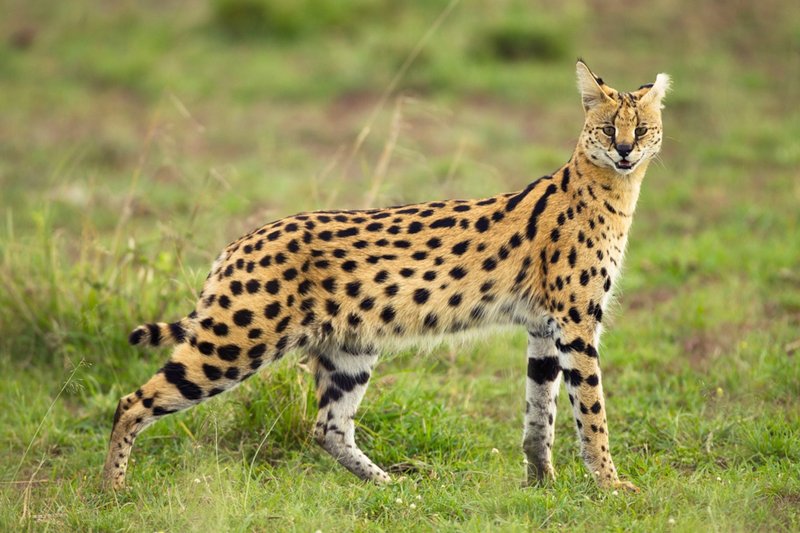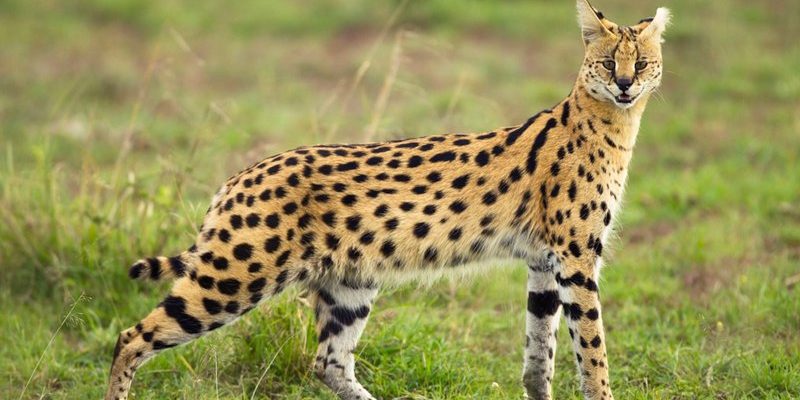
The Serval is a sleek, elegant wild cat that roams the grasslands and savannas of Africa. With its long legs, large ears, and distinctively spotted coat, this cat looks like nature’s version of a supermodel. You might even say it has a bit of a “catwalk” vibe as it navigates its environment with ease. But don’t let its graceful appearance fool you—this feline is also a remarkable predator, showcasing incredible skills that set it apart in the wild.
Imagine a cat that has evolved perfectly for its surroundings. The Serval’s long legs enable it to see over tall grasses, while its keen hearing helps it locate prey hidden beneath the foliage. Truly, the Serval embodies the spirit of the wild, demonstrating a unique blend of beauty and brawn. If you’re curious about what makes these cats tick, you’re in for a treat. Let’s dive deep into the world of the Serval and explore its habitat, diet, behavior, and more.
Physical Characteristics of the Serval
The first thing you notice about a Serval is its striking appearance. Standing about 24 to 36 inches tall at the shoulder, these cats are relatively small compared to other big cats. However, their slender bodies are perfectly adapted for agility. With long legs that can reach impressive heights, Servals are built for leaping. They can jump up to 10 feet in the air to catch birds or other prey. It’s like having springs in their legs!
The Serval’s coat is another remarkable feature. Typically gold or beige with distinctive black spots and stripes, it serves as excellent camouflage in their grassy habitats. This spotted pattern isn’t just for looks; it helps them blend in seamlessly with their surroundings, making it easier to surprise unsuspecting prey. Their large, rounded ears are designed for acute hearing, allowing them to detect even the tiniest rustle of movement. Think of them as nature’s perfect hunting machines, equipped with all the right tools.
| Size: | 24-36 inches at the shoulder |
| Weight: | 20-40 pounds |
| Habitat: | Grasslands, savannas, and wetlands in Africa |
| Diet: | Small mammals, birds, insects |
| Speed: | Up to 50 mph when sprinting |
| Lifespan: | 10-15 years in the wild |
Habitat and Distribution
Servals are native to Africa, predominantly found in sub-Saharan regions. They thrive in environments that provide ample cover, such as grasslands, wetlands, and even areas near riverbanks. These habitats offer both hiding spots for hunting and plenty of water sources for drinking. If you’ve ever explored the African savanna, you might have caught a glimpse of these elusive cats gracefully weaving through the tall grasses.
These felines are quite adaptable, which is essential for survival in changing environments. They often prefer habitats that are open but still have some shrubbery for shelter. You could say they are the ultimate opportunists of the feline world! As their habitats change, whether due to human activities or natural factors, Servals demonstrate a remarkable ability to adjust their hunting strategies and territories.
Diet and Hunting Behavior
The Serval is a carnivore that primarily feeds on small mammals, birds, and insects. Their incredible hunting skills set them apart as expert predators. They rely on their acute sense of hearing to detect the slightest movements of prey hiding in the grass. You’ll often see them stalk silently before launching a powerful leap, sometimes exceeding five times their body length. It’s like watching a skilled athlete perform a flawless routine!
What’s fascinating is their preference for certain types of prey. Servals tend to focus on rodents, which make up a significant portion of their diet. This is partly due to the abundance of rodents in the savanna ecosystem. They also have an impressive ability to hunt in water, using their agility to catch fish and amphibians when the opportunity arises. It’s one of those “you have to see it to believe it” scenarios—these cats are truly versatile hunters.
Social Behavior and Reproduction
Servals are generally solitary animals, spending most of their time alone unless they are mating or a mother is raising her young. Each Serval establishes its own territory, which can vary in size based on the availability of food and mates. You can think of their territories as private homes that they fiercely guard. Males typically have larger territories than females, which helps ensure access to more resources.
When it comes to mating, Servals are known for their unique courtship rituals. Males may engage in vocalizations, such as purring and growling, to attract potential mates. After a successful pairing, the female will give birth to a litter of 1 to 4 kittens in a den created from tall grass or rocky outcrops. The kittens are born blind and rely entirely on their mother for survival during the early weeks of life. As they grow, these little ones begin to explore their surroundings, learning vital skills for hunting and survival.
Conservation Status
Despite being relatively widespread, Servals face threats from habitat loss and hunting. As agriculture expands, their natural habitats are encroached upon, limiting their roaming areas and food sources. Additionally, they are sometimes hunted for their beautiful pelts. This situation has raised concerns among conservationists, who recognize the importance of preserving these unique animals.
Fortunately, efforts are underway to protect the Serval and its habitat. Numerous wildlife reserves and conservation programs are focusing on creating safe spaces for these cats to thrive. By raising awareness and supporting conservation initiatives, there is hope for the future of the Serval population. After all, who wouldn’t want to see these captivating creatures continue to roam the African landscapes?
Fun Facts About Servals
- The Serval is known for its impressive jumping abilities, allowing it to leap up to 10 feet in the air.
- They have a unique vocal repertoire, including purring, hissing, and growling to communicate.
- Servals can catch prey by swatting at it with their powerful forelimbs, often leading to successful hunts.
- These cats can rotate their ears independently, helping them pinpoint the exact location of sounds.
- The Serval is closely related to the African golden cat and the caracal, sharing similar hunting traits.
FAQ
What is the diet of a Serval?
Servals primarily feed on small mammals, birds, and insects. They are skilled hunters, often using their acute sense of hearing to detect prey hiding in the grass. The diet predominantly consists of rodents, which make up a significant portion of their meals. They even hunt in water, catching fish when the chance arises, showcasing their versatility.
Where do Servals live?
Servals are found throughout sub-Saharan Africa. They thrive in grasslands, savannas, and wetlands, preferring habitats that provide both cover and access to water. Their adaptability allows them to adjust their living conditions based on changing environments, making them a resilient species.
How do Servals communicate?
Servals communicate using a variety of vocalizations, including purring, hissing, and growling. These sounds help convey their feelings and intentions, especially during mating seasons. Their ability to make different sounds is crucial for establishing territory and attracting mates.
Are Servals good pets?
While Servals can exhibit playful and social behavior, they are not suitable as pets. Their wild nature, specific dietary needs, and large territories make it challenging to care for them in a home environment. Additionally, it’s crucial to respect wildlife and allow these magnificent creatures to thrive in their natural habitats.
How long do Servals live?
In the wild, Servals typically live around 10 to 15 years. Factors such as predation, food availability, and habitat conditions can affect their lifespan. In captivity, with proper care and nutrition, they can live longer, similar to other domesticated cats.
Do Servals have any natural predators?
Servals face threats from larger predators, including hyenas and lions, especially if they are caught in vulnerable situations. They rely heavily on their agility and camouflage to escape danger. Young Servals are particularly at risk, as they may not yet possess the skills to evade larger threats.
How do Servals hunt?
Servals use a combination of stealth and speed during hunting. They rely on their keen sense of hearing to locate prey hiding in the grass. Once they detect movement, they stalk silently before launching a powerful leap to catch their target. This method makes them incredibly effective hunters.
What is the conservation status of Servals?
Servals are currently classified as least concern by the IUCN, but they face threats from habitat loss and hunting. Conservation efforts are ongoing to ensure these beautiful animals continue to thrive in their natural environments. Protecting their habitats and raising awareness about their needs are key components of these efforts.
Can Servals swim?
Yes, Servals are capable swimmers. Although they primarily hunt on land, they can also catch fish and amphibians in water. Their agility allows them to adapt to various hunting environments, making them versatile predators capable of thriving in diverse habitats.
How are Servals different from domestic cats?
While Servals share some similarities with domestic cats, such as their playful nature, they are much larger and have different dietary and social requirements. Servals are wild animals, whereas domestic cats have been bred for companionship. This fundamental difference in behavior and needs makes Servals unsuitable as household pets.

